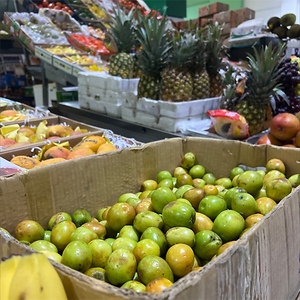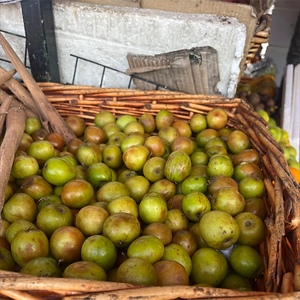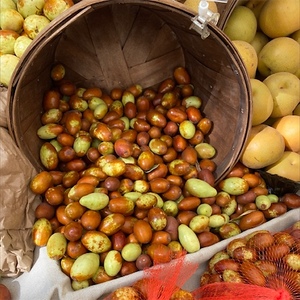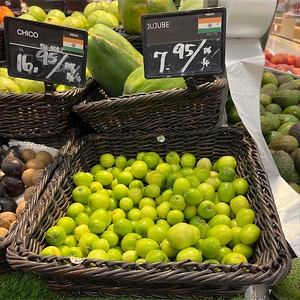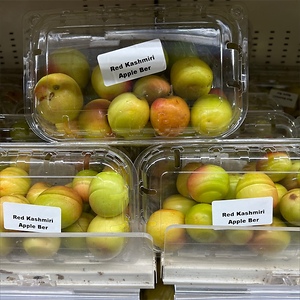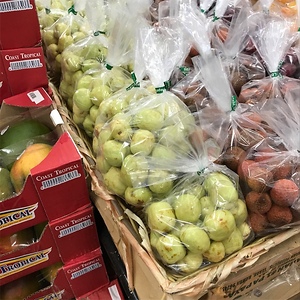

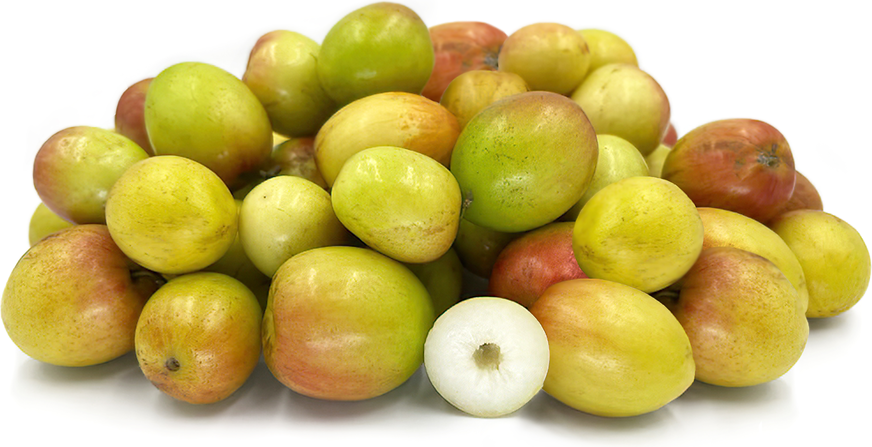
Ber (Indian Jujube)
Estimated Inventory, lb : 0
Description/Taste
Ber fruits vary in size and shape, depending on the specific variety and growing conditions, and generally average 1 to 3 centimeters in diameter and 2 to 7 centimeters in length. Wild types will have a smaller nature than cultivated types, and the fruits exhibit a round, oblong, or oval appearance with tapered and pointed or blunt, curved ends. The fruit’s skin is thin, smooth, taut, and glossy, showcasing variegated hues of green, yellow, orange, to red-brown, changing with the degree of ripeness. Slightly underripe Ber fruits will be more green or yellow, while mature fruits develop a red-brown blush. Underneath the surface, the white flesh is crisp, aqueous, and succulent when young, becoming crunchy and chewy with maturity. Ber fruits change in consistency as they ripen, and the flesh develops a notably more spongy, mealy texture with age. The fruits also encase an elongated, woody, central stone housing 1 to 2 seeds. Ber fruits are edible raw and have a sweet, tangy, refreshing flavor with subtle apple-like nuances when young. As the fruits mature, their flavor becomes milder and sweeter, sometimes with musky, tropical notes, depending on the variety.
Seasons/Availability
Ber fruits are generally available in the spring and fall, with the main crop occurring mainly in the spring.
Current Facts
Ber fruit, botanically classified as Ziziphus mauritiana, is a tropical to subtropical species belonging to the Rhamnaceae family. The fruits are commonly known as a type of jujube and are also called Indian jujubes in markets worldwide. It is important to note that some growers may call Ber fruits Chinese dates, but these should not be confused with Ziziphus jujuba or the Chinese jujube, a similar species that grows in temperate climates. The name Ber is the Hindi and Bengali name for jujube. The species is commercially produced throughout India and has many regional names, including Bor in Marathi, Elandi or Ilandai in Tamil, Regu Chettu in Telugu, and Bore Mara or Bore Hannu in Kannada. Ber fruits grow on small trees or large shrubs reaching 3 to 15 meters in height, and the trees are fast-growing, producing high yields on distinctly crooked, zigzag branches. Over ninety varieties of jujubes are generally categorized under the Ber name worldwide, and the fruits are commercially grown and planted in home gardens for culinary and medicinal purposes. Ber fruits can be eaten at various stages, and each point of maturity will yield a different flavor and texture for use in a wide array of fresh and cooked culinary preparations and beverages.
Nutritional Value
Ber fruits vary in vitamins and minerals, depending on the specific variety and growing conditions. The species, in general, is a source of vitamins A and C to strengthen the immune system and maintain healthy organs, calcium and phosphorus to support bones and teeth, and potassium to balance fluid levels and replenish electrolytes in the body. Ber fruits also provide iron to develop the protein hemoglobin for oxygen transport through the bloodstream, fiber to stimulate and regulate the digestive tract, magnesium to control nerve functions, and other nutrients, including copper and zinc. In Ayurveda and other natural medicines, Ber fruits are believed to have anti-inflammatory, antioxidant, and purifying properties. The fruits are incorporated into medicines to help with indigestion, lessen joint swelling, and improve sleep. Ber fruits are also dried and ground into a powder for cosmetic treatments. The powder is mixed with honey as a skin mask, and jujube seeds are crushed into oil and applied to the scalp to aid in hair growth.
Applications
Ber fruits have a sweet, sometimes tangy taste suited for fresh and cooked preparations. The fruits vary in flavor, texture, and use, depending on the specific variety and degree of ripeness. Jujubes, in general, are popularly consumed raw in their slightly underripe and ripe stages. The fruits can be eaten as a stand-alone snack or sprinkled with salt and chili powder for enhanced flavoring. Ber fruits can also be chopped and mixed into slaws and fruit salads, served on cheese platters, or finely chopped and stirred into various homemade trail mixes. In India, Ber fruits are incorporated into multiple chaat recipes, snack-like items sold through street vendors, or macerated with water as a cooling drink. These drink recipes also add ginger or coconut water for added nutritional benefits. Fresh Ber fruits are commonly cooked into chutney and are served with paranthas and roti. They are also cooked into cakes, bars, and jams or made into sweet and salty candies. There are many varieties of Ber fruits sold in Indian markets and consumers often have their preferences in cultivars for tea recipes or for stewing. Ber fruits are also pickled as a tangy condiment or sun-dried and added to fritters or baked goods. In addition to desserts, dried Ber fruits have a raisin-like quality and are used as a raisin substitute in dishes. Ber fruits pair well with spices such as ginger, cumin seeds, asafoetida, and cinnamon, tamarind paste, mint, red chile peppers, and lemon juice. Fresh Ber fruits should be stored in a sealed container in the refrigerator. The fruits can be consumed at desired ripeness, and if they need to be ripened further, they should be left at room temperature in a cool, dry, and dark place.
Ethnic/Cultural Info
A Ber tree in the city of Amritsar, Punjab, in northwestern India is known as Dukh Bhanjani Beri, or the “tree that will remove all sorrows or pain.” The tree was given its famous name by Sikh Guru Ram Das, and it was an ancient tree that naturally grew on the land where the Shri Harmandir Sahib, also known as the Golden Temple, was constructed during the 16th century. Ber fruit trees were considered sacred among the Sikhs, a religion and philosophy in the Punjab region. It is believed that the founder of the Sikhs, Guru Nanak, received enlightenment beneath a Ber tree, and the Dukh Bhanjani Beri tree was said to have once healed a leper when he bathed in the waters beside the tree. Dukh Bhanjani Beri is believed to be over 400 years old, and the tree still produces fruit. Devote Sikhs often visit the tree at the temple and sit beneath the tree in hopes that fruit will drop, as the fruits are never intentionally picked. Sikhs also still bathe in the water near the tree, a practice believed to heal ailments and pain.
Geography/History
Ziziphus mauritiana is native to Southeast and Southern Asian regions and has been growing wild since ancient times. Much of the species’ history surrounding its origins is unknown, and scientists often debate the native area, sometimes expanding it to include parts of East Asia. Regardless of these debates, wild strains of Ziziphus mauritiana were eventually selected for cultivation and were bred for improved traits, especially in India. Ziziphus mauritiana was spread over time to areas of the Middle East, Asia, Africa, and Australia and naturalized in several of these locations. The species also became an invasive plant in some regions of northern Australia. Ber fruits were traditionally consumed as a food source and were considered the “poor man’s apple or food” in India due to their widespread availability. They were also incorporated into natural medicines, and other portions of the tree, including the bark, wood, and leaves, were used in making dyes, construction materials, and wooden toys. Today, Ber fruits have spread worldwide and are cultivated in the Americas as a specialty fruit. Ber fruits are grown for commercial production and home garden use, and the most extensive production occurs in India. The species thrives in drier tropical to subtropical areas and is also still found wild in its native regions. When in season, Ber fruits are sold fresh directly through growers, at local fresh markets, or through select grocers and wholesalers. The fruits are also offered through vendors dried and preserved.
Recipe Ideas
Recipes that include Ber (Indian Jujube). One
| The Secret Ingredient |
|
Green Ber Ki Chutney |



